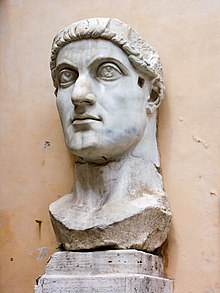Constantine I the Great
|
|||||
|---|---|---|---|---|---|

Marble head representing Emperor Constantine the Great, at the Capitoline Museums
|
|||||
| 57th Emperor of the Roman Empire | |||||
| Reign |
|
||||
| Predecessor | Constantius I | ||||
| Successor | |||||
| Born | 27 February c. 272 Naissus, Moesia Superior, Roman Empire (present-day Niš, Serbia) |
||||
| Died | 22 May 337 (aged 65) Nicomedia, Bithynia, Roman Empire |
||||
| Burial | Church of the Holy Apostles, Constantinople | ||||
| Spouse | |||||
| Issue | |||||
|
|||||
| Dynasty | Constantinian dynasty | ||||
| Father | Constantius Chlorus | ||||
| Mother | Helena | ||||
| Religion |
|
||||
| Full name | |
|---|---|
| Flavius Valerius Aurelius |
| Saint Constantine the Great | |
|---|---|
| Emperor and Equal to the Apostles | |
| Venerated in | |
| Feast | 21 May |
| Attributes | Christogram |
| Patronage | new discoveries |
Constantine the Great (Latin: Flavius Valerius Aurelius Constantinus Augustus;Greek: Κωνσταντῖνος ὁ Μέγας; 27 February c. 272 AD – 22 May 337 AD), also known as Constantine I or Saint Constantine (in the Orthodox Church as Saint Constantine the Great, Equal-to-the-Apostles), was a Roman Emperor of Illyrian-Greek origin from 306 to 337 AD. He was the son of Flavius Valerius Constantius, a Roman Army officer, and his consort Helena. His father became Caesar, the deputy emperor in the west, in 293 AD. Constantine was sent east, where he rose through the ranks to become a military tribune under Emperors Diocletian and Galerius. In 305, Constantius raised himself to the rank of Augustus, senior western emperor, and Constantine was recalled west to campaign under his father in Britannia (Britain). Constantine was acclaimed as emperor by the army at Eboracum (modern-day York) after his father's death in 306 AD, and he emerged victorious in a series of civil wars against Emperors Maxentius and Licinius to become sole ruler of both west and east by 324 AD.
As emperor, Constantine enacted many administrative, financial, social, and military reforms to strengthen the empire. The government was restructured, and the civil and military authorities were separated. A new gold coin was introduced to combat inflation known as the solidus. It became the standard for Byzantine and European currencies for more than a thousand years.
...
Wikipedia
